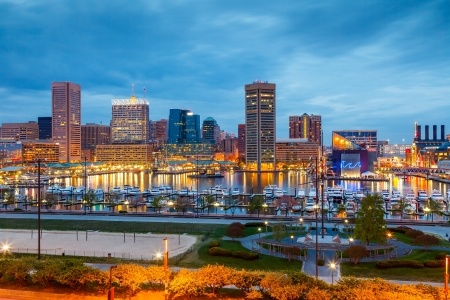In Maryland, the success of the state as a whole largely depends on the success of its immigrants. The United States has many pockets where foreign entrepreneurs tend to prefer to move and open new businesses, due in part to friendly local attitudes towards foreigners, and Maryland is one of the more noteworthy of these pockets. Since the mid-1800’s, the Port of Baltimore has offered hope to countless immigrants as one of the primary entry points to the United States.
This welcoming reputation continues into modern times, and as of August 2016, Maryland hosts over 886,000 immigrants, who comprise 14% of the state’s total population. These immigrants and foreign entrepreneurs enhance many of the state’s most prominent, necessary industries, including manufacturing, healthcare, innovation, and STEM fields. They fill the state’s employment gaps, and provide jobs for thousands of Americans. Between 2000 and 2013, immigration to Maryland expanded by 57.6%, with most of the state’s new foreign-born residents coming from El Salvador, India, and the Philippines. Maryland has the highest household income in the United States, $70,004, meaning that residents are well-off, and can afford the goods and services provided by immigrant entrepreneurs.
immigrants and foreign entrepreneurs enhance many of the state’s most prominent, necessary industries, including manufacturing, healthcare, innovation, and STEM fields. They fill the state’s employment gaps, and provide jobs for thousands of Americans. Between 2000 and 2013, immigration to Maryland expanded by 57.6%, with most of the state’s new foreign-born residents coming from El Salvador, India, and the Philippines. Maryland has the highest household income in the United States, $70,004, meaning that residents are well-off, and can afford the goods and services provided by immigrant entrepreneurs.
Immigrant Economic Contribution
In the manufacturing industry alone, immigrants in Maryland hold about 37,000 positions as of 2010. The state’s healthcare system is also heavily reliant on immigrants. As of 2016, Maryland has the 12th-highest number of foreign-born doctors, and in 2013 about ¼ of Maryland’s nurses were immigrants. About ¼ of Maryland’s healthcare professionals graduated from foreign medical schools. Maryland’s immigrants tend to hold advanced degrees. As of 2013, 30.2% of the state’s STEM graduates and 54.3% of engineering PHDs were foreign-born. These graduates go on to support development in some of the world’s fastest-growing industries.
About 21.2% of Maryland’s business owners are foreign-born entrepreneurs, and their companies generate over $2.8 billion in annual income, meaning Maryland has the seventh-highest rate of immigrant business ownership in the United States. Immigrants in Maryland have helped to shape the world as we know it, with companies like aerospace giant Lockheed Martin, which was founded by the children of Scottish immigrants, and Baltimore Gas and Electric, which was founded by a German immigrant, calling the state home. These two companies employ about 125,000 people and earn over $49 billion each year. In 2013, for the 4,490 H-2B visas granted in Maryland, about 20,834 jobs were created, showing a correlation between immigration and job growth.
Hispanic immigrants, in particular, represent a significant contribution to Maryland’s economy. According to a report published by the Partnership for a New AmericanEconomy, Hispanic immigrants hold about $8.2 billion in spending power, and contribute about $2.9 billion towards local, federal, and state taxes.
Conversely, Maryland suffers economically when its immigration decreases. It is estimated that H-1B visa denials during 2007 and 2008 cost the D.C., Maryland, and Virginia metropolitan area about 30,222 jobs in the tech industry, which represented about $519,417,000 in lost wages. With numbers like these in mind, Maryland is increasingly open to immigration reform and creating opportunities for foreign entrepreneurs such as the E-2 treaty investor visa, L-1A executive/managerial visa and EB-5 direct investment/green card.
Baltimore Overview
Baltimore is Maryland’s largest  city, with about 621,849 residents as of 2015 and about 2.7million in the Baltimore Metropolitan Area. Founded in 1729, it is an area steeped in history, and has more public monuments than any other city in the United States. Baltimore was once one of the major manufacturing centers and ports in the northeast, but has since shifted towards a service-oriented economy. Baltimore is renowned for is cuisine, particularly its blue crabs and other seafood, and its distinctive architecture. It has had numerous famous residents, including writers Edgar Allan Poe and Frederick Douglass, singer Billie Holiday, baseball star Babe Ruth, and the writer of The Star-Spangled Banner, Frances Scott Key. The city is home to a huge number of museums, theaters, historical districts, convention centers, and more, meaning that, no matter someone’s preferences, they will always find something in Baltimore to pique their interest.
city, with about 621,849 residents as of 2015 and about 2.7million in the Baltimore Metropolitan Area. Founded in 1729, it is an area steeped in history, and has more public monuments than any other city in the United States. Baltimore was once one of the major manufacturing centers and ports in the northeast, but has since shifted towards a service-oriented economy. Baltimore is renowned for is cuisine, particularly its blue crabs and other seafood, and its distinctive architecture. It has had numerous famous residents, including writers Edgar Allan Poe and Frederick Douglass, singer Billie Holiday, baseball star Babe Ruth, and the writer of The Star-Spangled Banner, Frances Scott Key. The city is home to a huge number of museums, theaters, historical districts, convention centers, and more, meaning that, no matter someone’s preferences, they will always find something in Baltimore to pique their interest.
Baltimore Economy
Although Baltimore was once a manufacturing economy based on shipping, auto manufacturing, and steel processing, it has since changed to a primarily service-based economy. Baltimore suffered when its steel plant closed in 2012, but it is regaining traction by becoming a hub for technology. The CBRE Tech Talent Report named it 8th in the U.S. in terms of number and growth rate for technology workers. According to Forbes, Baltimore is 4th in the nation on its list of “new tech hot spots.” As of 2013, nearly ¼ of jobs in Baltimore were in STEM fields, and the city is home to well-known, large companies like Johns Hopkins Hospital and Under Armour. The area is a hub for higher education, and hosts the renowned Johns Hopkins University, which is one of the city’s major employers.
Baltimore Immigration
Despite its de-industrialization, Baltimore is still a prominent U.S. port, and is home to the World Trade Center Baltimore, which saw over 29.5 million tons of cargo in 2014, valued at $52.5 billion. In 2014, the Port of Baltimore generated $3 billion in wages for its over 14,630 employees. The port also supports a cruise industry, which generates over 500 jobs and brings in over $90 million each year. The proximity of the port makes Baltimore an excellent location for foreign entrepreneurs who need to ship goods to and from other countries, which is ideal for those seeking the E-1 Treaty Trader visa. Due to its high number of historical sites, Baltimore also enjoys a bustling tourism industry, which drew in over 24.5 million tourists in 2014, who spent over $5.2 billion.
Support for Immigrants in Maryland
Foreign entrepreneurs in need of support will find plenty of help at the Maryland Department of Commerce’s Small Business and Entrepreneur Resource Department, which offers advice and mentorship. The University of Maryland has established its willingness to provide affordable work spaces for immigrant entrepreneurs seeking to create and innovate, and the local government is dedicated to tapping into the insight provided by immigrants to continue to enrich the economy. All told, Maryland, particularly Baltimore, hosts a wealth of opportunities for foreign entrepreneurs, especially those seeking to enter STEM fields or any of the state’s other thriving industries.
Moving to the United States to make a new start as an immigrant entrepreneur is a challenging process. Visa applicants face a huge number of critical decisions before submitting their visa application, one of the most important of which is deciding which State will offer the best environment for their business to grow and thrive, and provide the optimal environment for their families. Each State has its own opportunities and industry specializations, and a company that sees tremendous growth in one State might not see the same results in another.

In order to help its clients decide which State will serve as the most advantageous home base, both for their businesses and their families, and further streamline the visa application process, JDC Consultancy publishes brief overviews of what each State has to offer its immigrant entrepreneurs. These featurettes showcase each State’s strengths, in this case, Maryland, and provide valuable insight and statistics to help immigrant entrepreneurs make the all-important decision of which State they, and their businesses, should call home.

